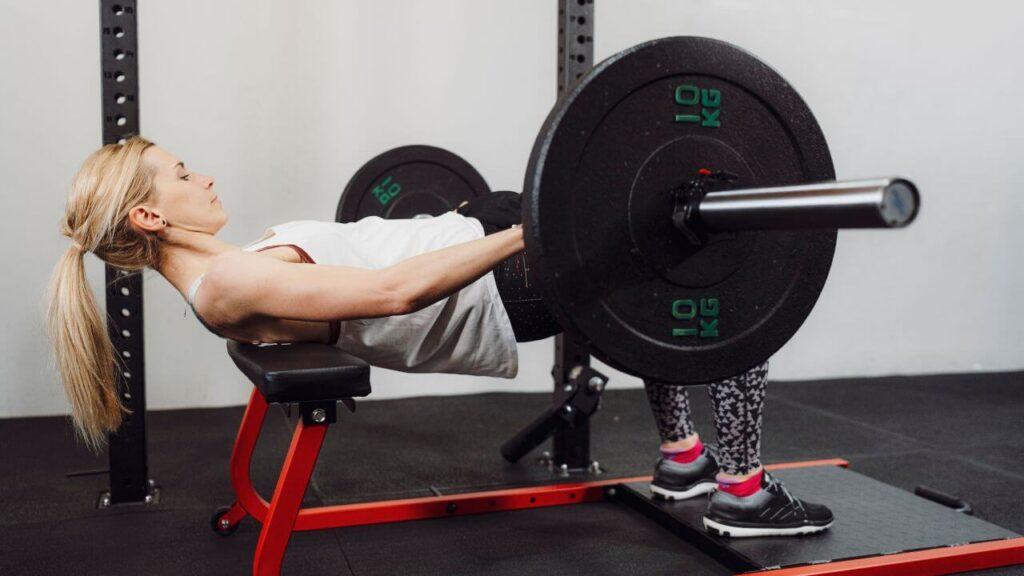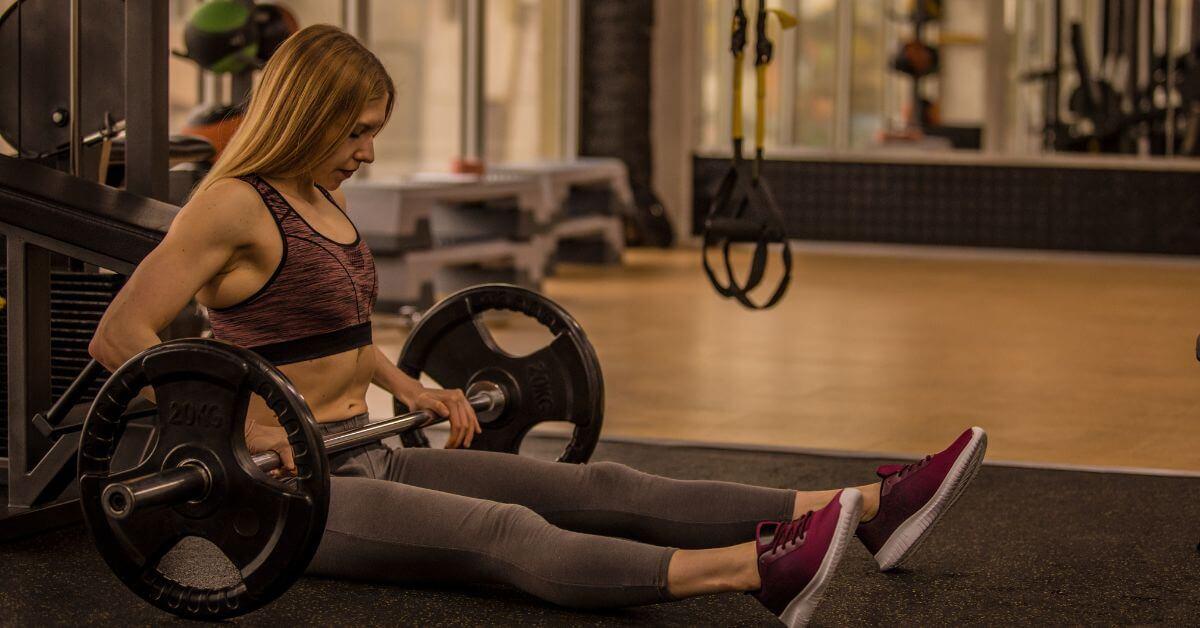The hip thrust is one of the best lower body exercises for developing strength and explosiveness. It is heavily used in regular fitness and sport-specific scenarios due to its effectiveness and ability to carry the most benefits to the field/court or real life. However, are hip thrusts a compound exercise?
Table of Contents
ToggleHip thrusts are a lower body compound exercise. Hip thrusts build lower body strength and explosiveness by activating muscles such as the hamstrings and glute complex. Essentially, they are a bridge exercise with bilateral and unilateral variations.
If you are a hip thrust lover, you may want to keep reading below since I prepared a significant amount of information on muscles worked, their benefits, how to grow your glutes, and more. Stick until the end to see if hip thrusts are better than squats for building glutes and lower body strength in general.
Start Building Your Dream Body Today
Ready to elevate your fitness game without falling into the trap of dull, repetitive routines that just don’t deliver? Imagine sculpting your ideal physique and boosting your health, all while still enjoying life’s pleasures, like those irresistible weekend getaways and your aunt’s legendary cheesecake. With our online fitness and nutrition coaching service, you don’t have to compromise. Dive into a personalized fitness journey that blends perfectly with your lifestyle, not against it. Book your completely free discovery consultation today, and take the first step towards a transformation that doesn’t require giving up the joys of life.

“I was skeptical about online fitness coaching, but Functional Body Savage completely changed my perspective. Vanja and Radomir’s personalized approach and attention to detail have helped me achieve goals I never thought possible. I’m stronger, more confident, and grateful for their guidance.”
Emily Thompson, San Francisco, CA
Learn More About Our Online Coaching ServiceQuick Summary
- The hip thrust is an excellent compound lower body exercise for building strength and power.
- Hip thrust activates multiple muscle groups, and some include gluteal and hamstrings muscles.
- You should always aim to place your hip thrust after squatting since squats are more taxing for your CNS and energy levels.
What Is Hip Thrust?
The hip thrust is a lower-body compound exercise. In addition, it is a glute bridge variation performed using external resistance or your body weight to lift yourself from the floor.
It is excellent for building your posterior chain muscles and has numerous benefits for both recreational fitness and sport-specific scenarios. Hip thrust involves the hip extension and is similar to the deadlift movement pattern but doesn’t activate lower back muscles such as erector spinae, which is the main difference along with the starting position.
What Muscles Are Worked?
The muscles worked during a hip thrust exercise are posterior chain muscles. Posterior chain muscles include the hamstrings and glutes.
Hamstring muscles that work during hip thrust are semimembranosus, semitendinosus, and biceps femoris. Glute muscles worked during the hip thrust exercise include the gluteus medius, minimus, and maximus. However, the quadriceps and adductor complex also work during hip thrusting but function as either synergists or stabilizers.
Why Are Hip Thrusts So Effective?
Hip thrusts are so effective because they exercise your glutes, hamstrings, quadriceps, and adductors without placing too much pressure on your lower back. The hip thrust is a functional exercise that helps stabilize your lower back, pelvis, and knees, making it ideal for correcting low bone density in the femur and hips and aligning the knee joints.
Compound exercises, such as hip trusts, are effective in building lower body strength and explosiveness and can be combined with different lower body exercises to achieve even greater results.
“Generally, I prefer to train the muscles as they were intended to be used. In the case of the hip muscles, that means stabilizing the legs. This will better train the movement patterns we want to learn, and it will strengthen them in a useful manner.” – Adam Sinicki, AKA The Bioneer, author of the Functional Fitness and Beyond
Can I Grow My Glutes With Just Hip Thrusts?
Yes, you can grow your glutes with just hip thrusts. Hip thrusts will effectively target your glute muscles, such as the gluteus medius, minimus, and maximus, and induce the maximum hypertrophy effects.
Both bodyweight, weighted, unilateral, and bilateral hip thrusts can be used to grow your glutes and should be incorporated into your workout plan accordingly.
How Do You Do a Hip Thrust?
To do a hip thrust:
- Place your back against an elevated surface, such as a bench or box, with your knees bent and feet flat on the ground, slightly rotated outwards.
- The elevated surface should hit below your shoulder blades(scapula), and your feet should be shoulder-width apart. Your elbows can be in the resting position on the bench.
- Start pushing your heels until your thighs are parallel to the floor, and your legs should form a 90-degree angle.
- Squeeze your glutes at the top for 1-2 seconds and return to the starting position.

How Can You Add Hip Thrusts to Your Routine?
You can add hip thrusts to your routine by implementing them into your lower body workouts. In addition, you should aim for at least one session of hip thrusting during a week, and if you do splits, you can incorporate two.
Also, aim to program your hip thrusting on the days you mainly work your posterior chain to maximize hypertrophy effects. However, you shouldn’t place hip thrusts before deadlifts since you will likely tax your CNS and lose energy, preventing you from performing deadlifts correctly. In addition, don’t place hip thrust before squats since the same will happen. You can implement hip thrusts as an accessory lift to your main lifts, meaning you should do it after you finish with the big compound movements such as squats and deadlifts.
What Are the Most Common Mistakes to Watch For?
The most common hip thrust mistakes to watch for include not pushing your feet into the ground, not activating your glues before the exercise, and placing your feet too far away.
Here is the list of some most common hip thrust mistakes:
- Not warming up your posterior chain muscles before hip thrusting – ensure to warm up your gluteus medius, minimus, maximus, and hamstring muscles.
- Placing your feet too far away or too wide – try bringing your feet closer to your hips and position them shoulder-width apart.
- Not pushing the ground away from you – aim to push with your feet throughout the full range of motion.
- Working on the wrong height – your upper back should be comfortably positioned against the elevated surface.
- Loading unsafely – if you can’t safely load the bridge, ask someone or a partner to help you.
- Not focusing on the eccentric phase – eccentric phase is responsible for most muscle hypertrophy so ensure to slow it down.
To ensure the maximum benefits of hip thrusting, try implementing tempo training. Tempo training aims to focus on different phases of your lifts to maximize strength, hypertrophy, and power. Those phases include eccentric, isometric, and concentric.
Hip Thrust Variations
Here is the list of the most common hip thrust variations:
- Bodyweight Hip Thrust
- Hip Thrust with Abduction
- Banded Hip Thrusts
- Single Leg Hip Thrust
- Banded Hip Thrust with Abduction
- Banded Single Leg Hip Thrust
- Banded Barbell Hip Thrust
- Barbell Hip Thrust
- 1 ½ Hip Thrust
- B-Stance Hip Thrust
- Single Leg Weighted Hip Thrust
- Sandbag Hip Thrust
- Single Leg Sandbag Hip Thrust
- Hip Thruster Machine
- Leg Extension Hip Thrusts
- Frog Pump
- Banded Dumbbell Hip Thrust
- Dumbbell Hip Thrust
How Often Should You Do Hip Thrusts?
You should do hip thrusts at least 1-2 times a week. This amount of sessions will ensure you build strength in your posterior chain muscles and induce maximal hypertrophy benefits.
However, the number of sessions will differ based on your training goals. One heavy session will be enough if you want to build strength or power. On the contrary, if your goal is endurance or hypertrophy, doing multiple weekly sessions with an adequate resting period will be enough.
How Much Weight Should I Use for Hip Thrusts?
How much weight you should use for hip thrust will depend on your goals. For beginners, it is best to start with bodyweight unilateral and bilateral hip thrusts.
For experienced trainees seeking to build endurance and hypertrophy, 6-12 repetitions with 60-80% of 1RM will do it. On the contrary, for trainees seeking to build strength or power, the best amount of repetitions is below 6, and the weight should be set for 80% of 1RM and more.
Is Hip Thrust Better Than Squats?
The hip thrust is better than squats only in certain situations. However, squats are an essential compound exercise that can’t be substituted easily.
Both hip thrusts and squats should be incorporated into your workout plan according to your goals, injury history, muscle imbalances, and similar.
FAQs
Do Hip Thrusts Build Mass?
Yes, hip thrusts build mass. Hip thrusts will build muscle in your posterior chain, including your glutes and hamstrings.
What Exercise Is Better Than Hip Thrust?
Squats are better than hip thrusts. However, it isn’t the right way to evaluate which exercise is better since both have their unique place and functions in a functional training program.
Should I Squat or Hip Thrust First?
You should both squat and hip thrust at the same time. Squats may be a more demanding exercise compared to hip thrusts, but both should be implemented into your workout program.
Do Hip Thrusts Give You Abs?
No, hip thrusts don’t give you abs. You may have to stabilize your hip by activating your abdominal muscles, but that won’t be enough to build hypertrophy and induce muscle growth in your abdominal musculature.
How Can You Progress Hip Thrusts Without Adding More Weight?
You can progress hip thrusts without adding more weight by doing a unilateral variation. Put one leg in the air, and do the same as with both legs, just this time, it will be harder since you are pushing the same amount of weight with a single leg.
Are Hip Thrusts Better Than Squats?
Both hip thrusts and squats are excellent exercises for building lower body strength and power.
One may have slight advantages compared to the other, but generally, both should be implemented in a single functional program to ensure maximal benefits.
Always aim to place your squats earlier in the workout, and your hip thrusts can be performed later since the first are much more taxing for the central nervous system and body energy.
Let me know in the comments below what is your favorite hip thrust variation and what you like more, squats or hip thrusts.
Start Building Your Dream Body Today
Ready to elevate your fitness game without falling into the trap of dull, repetitive routines that just don’t deliver? Imagine sculpting your ideal physique and boosting your health, all while still enjoying life’s pleasures, like those irresistible weekend getaways and your aunt’s legendary cheesecake. With our online fitness and nutrition coaching service, you don’t have to compromise. Dive into a personalized fitness journey that blends perfectly with your lifestyle, not against it. Book your completely free discovery consultation today, and take the first step towards a transformation that doesn’t require giving up the joys of life.

“I was skeptical about online fitness coaching, but Functional Body Savage completely changed my perspective. Vanja and Radomir’s personalized approach and attention to detail have helped me achieve goals I never thought possible. I’m stronger, more confident, and grateful for their guidance.”
Emily Thompson, San Francisco, CA
Learn More About Our Online Coaching Service





